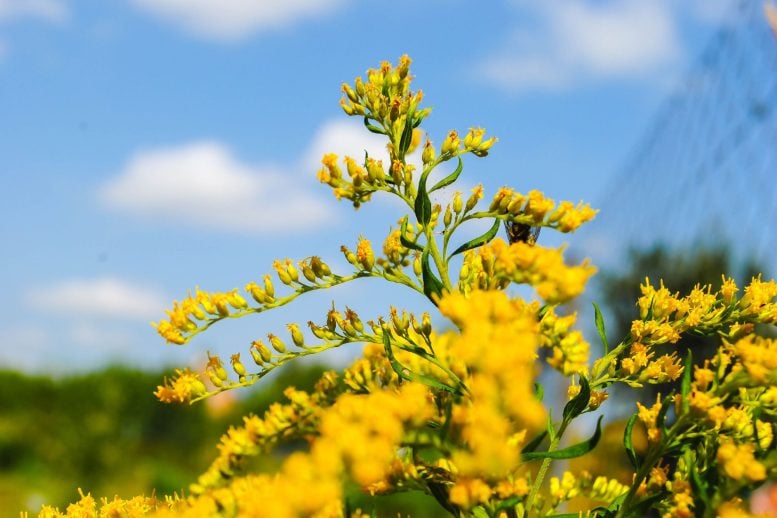Goldenrod plants can sense other nearby plants via far-red light ratios and adjust their responses when eaten by herbivores, suggesting some form of plant intelligence. Andre Kessler, a chemical ecologist, advocates plant intelligence by defining it as the ability to solve problems based on environmental information. His research shows that goldenrod emits chemicals to signal neighboring plants to produce defenses against pests. This adaptive behavior and communication via volatile organic compounds indicate that plants can process information and respond flexibly to their environment, challenging traditional notions of intelligence. Credit: SciTechDaily.com
New research shows that goldenrod plants demonstrate a form of intelligence by adapting their responses to herbivores based on the presence of neighboring plants and environmental cues, challenging traditional definitions of intelligence.
Goldenrod can sense other plants nearby without ever touching them, by sensing the proportions of far-red light reflected from leaves. When eaten by herbivores, goldenrod adjusts its response based on whether or not another plant is nearby. Is this kind of flexible, real-time, adaptive response a sign of intelligence in plants?
The question is not easy to answer, but Andre Kessler, a chemical ecologist, argues for the intelligence of plants in a recent article in the journal Plant signaling and behavior.
Defining intelligence in plants
“More than 70 definitions have been published for intelligence, and there is no consensus on what it is, even within a given field,” said Kessler, a professor in the Department of Ecology and Evolutionary Biology in the College of Agriculture and Life Sciences.
Many people believe that intelligence requires a central nervous system, in which electrical signals act as a medium for processing information. Some plant biologists equate plants’ vascular systems with central nervous systems, proposing that some sort of centralized entity within the plant allows them to process information and respond. But Kessler strongly disagrees with that idea.

A goldenrod plant.
“There is no good evidence for any homology with the nervous system, even though we clearly see electrical signals in plants, but the question is how important are those signals for a plant’s ability to process signals from the environment?” He said.
To make their case for plant intelligence, Kessler and co-author Michael Mueller, a doctoral candidate in his lab, distilled their definition down to its most fundamental elements: “The ability to solve problems based on the information you extract the environment, toward a certain goal,” Kessler said.
As a case study, Kessler points to his previous research on goldenrod and its responses when eaten by pests. When leaf beetle larvae eat goldenrod leaves, the plant emits a chemical that informs the insect that the plant is damaged and is a poor food source. These airborne chemicals, called volatile organic compounds (VOCs), are also picked up by neighboring goldenrod plants, causing them to produce their own defenses against the beetle larvae. In this way, goldenrods move herbivores to neighbors and distribute the damage.
Experiments and observations
In a 2022 article in the magazine Plants, Kessler and co-author Alexander Chautá, Ph.D. ’21, conducted experiments to show that goldenrod can also sense higher far-red light ratios reflected from leaves of neighboring plants. When neighbors are present and goldenrods are eaten by beetles, they invest more in tolerating the herbivore by growing faster, but also begin to produce defensive compounds that help the plants fight insect pests. If no neighbors are present, the plants do not resort to accelerated growth when eaten and the chemical responses to herbivores are considerably different, although they still tolerate quite large amounts of herbivores.
“This would fit our definition of intelligence,” Kessler said. “Depending on the information it receives from the environment, the plant changes its default behavior.”
Neighboring goldenrods also exhibit intelligence when sensing VOCs that signal the presence of a pest. “The fugitive emissions coming from a neighbor are predictive of future herbivory,” Kessler said. “They can use an environmental signal to predict a future situation, and then take action on it.”
Applying the concept of intelligence to plants could inspire new hypotheses about the mechanisms and functions of plants’ chemical communication, while also changing people’s thinking about what intelligence really means, Kessler said.
This last idea is timely, like artificial intelligence is a current topic of interest. For example, he said, artificial intelligence doesn’t solve problems for a specific purpose, at least not yet. “Artificial intelligence is not even intelligent according to our definition of intelligence,” he said. Instead, it is based on the patterns it identifies in the information it accesses.
One idea that interests Kessler came from mathematicians in the 1920s who proposed that plants might function more like beehives. In this case, each cell works like an individual bee, and the entire plant is similar to a beehive.
“What that means is that the brain in the factory is the whole factory, without the need for central coordination,” says Kessler.
Instead of electrical signals, there are chemical signals throughout the superorganism. Studies by other researchers have shown that each plant cell has a broad light spectrum and sensory molecules to detect highly specific volatiles coming from neighboring plants.
“They can smell their environment very precisely; as far as we know, any cell can do it,” he said. Cells may be specialized, but they also all sense the same things, and they communicate via chemical signals to initiate a collective response in terms of growth or metabolism. “I really like that idea,” he says.
Reference: “Induced resistance to herbivory and the intelligent plant” by André Kessler and Michael B. Mueller, April 30, 2024, Plant signaling and behavior.
DOI: 10.1080/15592324.2024.2345985
The article was supported by a grant from the New Phytologist Fund.
